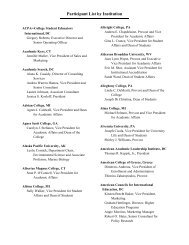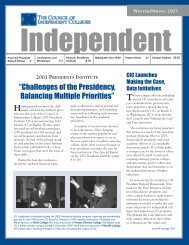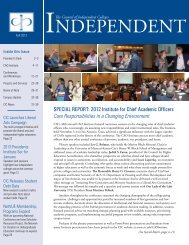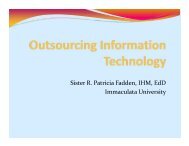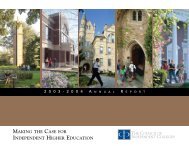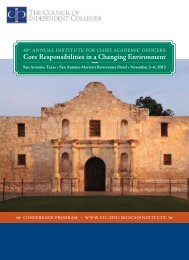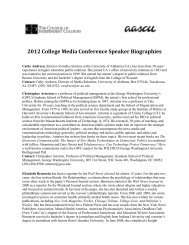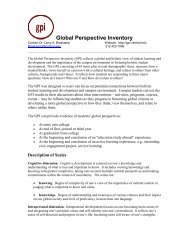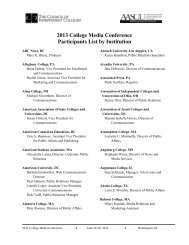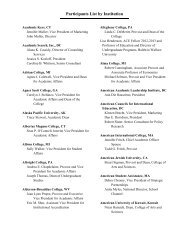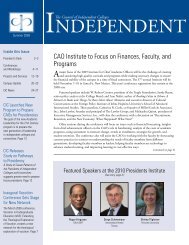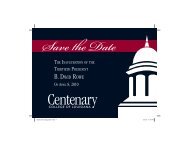Meeting the Challenge: - The Council of Independent Colleges
Meeting the Challenge: - The Council of Independent Colleges
Meeting the Challenge: - The Council of Independent Colleges
Create successful ePaper yourself
Turn your PDF publications into a flip-book with our unique Google optimized e-Paper software.
From Accreditation to Validation: CIC’s First Half-Century<br />
Faculty members are ano<strong>the</strong>r campus constituency<br />
that CIC has long sought to serve. When Gary Quehl<br />
assumed <strong>the</strong> presidency in 1974, CASC was just beginning<br />
a project on faculty development that involved <strong>the</strong><br />
president, dean, and nine faculty members from each <strong>of</strong> 40<br />
institutions. <strong>The</strong> project involved several intensive training<br />
sessions over an 18-month period in 1974-1975. In addition<br />
to a week-long session at CASC’s National Institute, <strong>the</strong><br />
program required teams to participate in smaller regional<br />
workshops and to create faculty development programs on<br />
<strong>the</strong>ir own campuses, aided by competitive grants from <strong>the</strong><br />
<strong>Council</strong>. CIC was a national leader in faculty development<br />
in <strong>the</strong> 1970s, publishing two widely used volumes in <strong>the</strong><br />
series A Handbook for Faculty Development. A third volume<br />
appeared in 1981. During <strong>the</strong> 1980s and 1990s, CIC <strong>of</strong>fered<br />
an annual series <strong>of</strong> regional workshops for faculty members,<br />
addressing a range <strong>of</strong> issues in teaching and learning. In<br />
2001, <strong>the</strong>se regional workshops were redesigned to focus on<br />
<strong>the</strong> needs <strong>of</strong> division and department chairs, with sessions<br />
on such topics as recruitment and hiring, <strong>the</strong> evaluation<br />
<strong>of</strong> faculty members, and improving interdepartmental<br />
cooperation.<br />
This focus on faculty issues also included a 1985<br />
project on faculty morale and <strong>the</strong> quality <strong>of</strong> <strong>the</strong> academic<br />
workplace, culminating in A Good Place to Work: Sourcebook<br />
for <strong>the</strong> Academic Workplace. This book documented <strong>the</strong><br />
distinctive outlook <strong>of</strong> faculty members at CIC institutions:<br />
higher morale, on average, than faculty members at o<strong>the</strong>r<br />
types <strong>of</strong> institutions; values that matched <strong>the</strong> values <strong>of</strong> <strong>the</strong>ir<br />
institutions; an awareness <strong>of</strong> <strong>the</strong> important role that college<br />
presidents played in promoting job satisfaction among faculty<br />
members; and a somewhat different definition <strong>of</strong> scholarship<br />
than <strong>the</strong>ir peers maintained at o<strong>the</strong>r institutions. In <strong>the</strong> mid-<br />
1990s, a major project funded by <strong>the</strong> Pew Charitable Trusts<br />
looked at “Faculty Roles and Rewards.”<br />
1993<br />
CIC receives a $1.25 million grant from Atlantic Philanthropies<br />
for Serving to Learn, Learning to Serve. CAPHE<br />
also receives a $1 million grant from <strong>the</strong> DeWitt Wallace<br />
Reader’s Digest Fund (now <strong>the</strong> Wallace Foundation) to develop<br />
academic partnerships between community groups<br />
and local colleges.<br />
78



